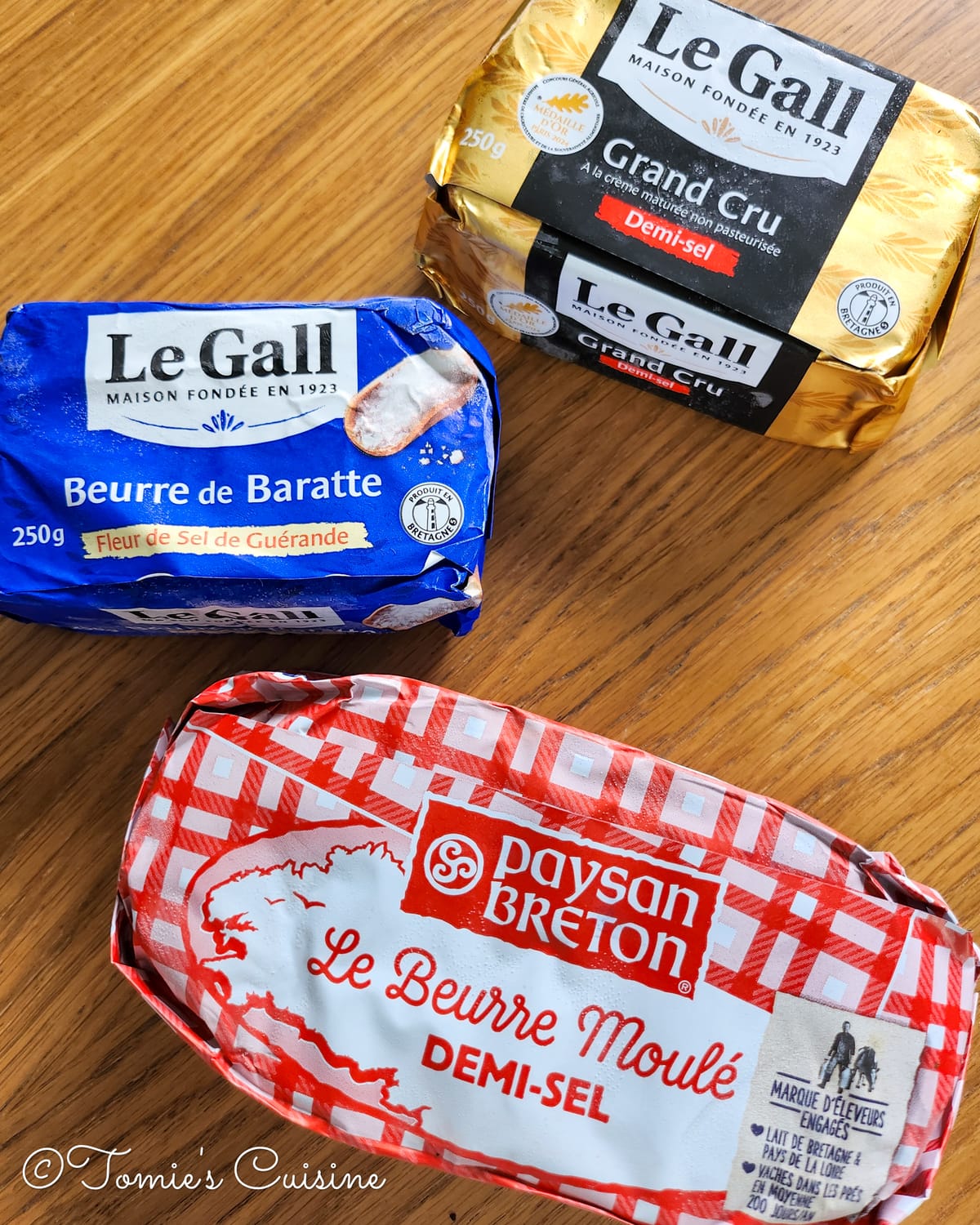How do I get to Brittany from England by car?
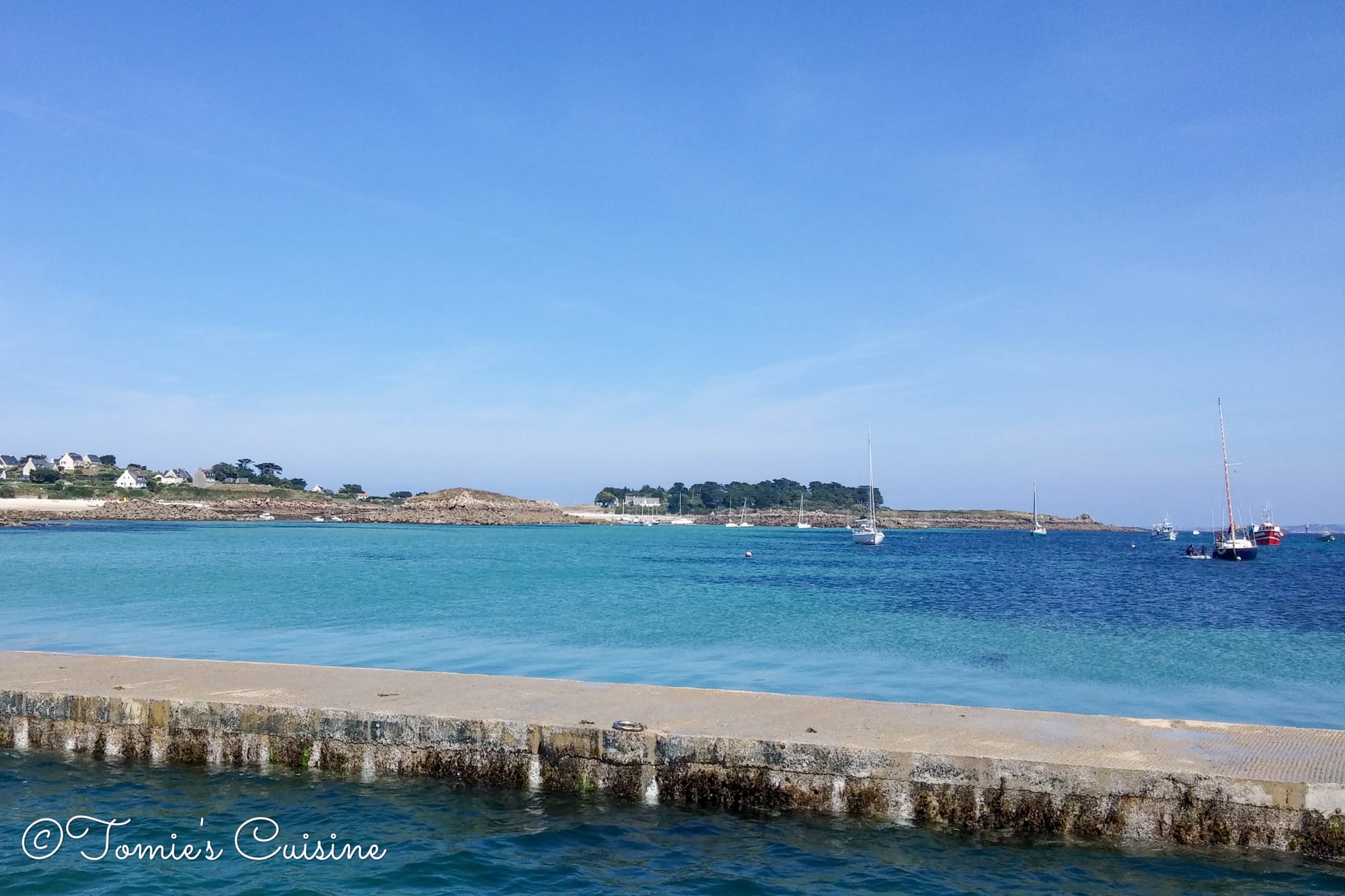
We usually take the ferry by car run by Brittany Ferries, which departs from Portsmouth or Plymouth to St.Malo or Roscoff.
It’s not to Brittany, but we also took a ferry from Poole to Cherbourg (Normandy), Portsmouth to Caen, and Euro tunnel (LeShuttle) from Folkestone to Calais (when we went to Braderie de Lille). We also drove from Calais to Brittany; it is mostly motorway and takes about 6 hours. There are many ways to get to France other than by plane!
Brittany is full of delicious treasures!
My other half is from Brittany. These products from Brittany are what both of us love and bring back as much as we can. It’s a recommendation from a local and someone who goes there often.
Roscoff pink onions
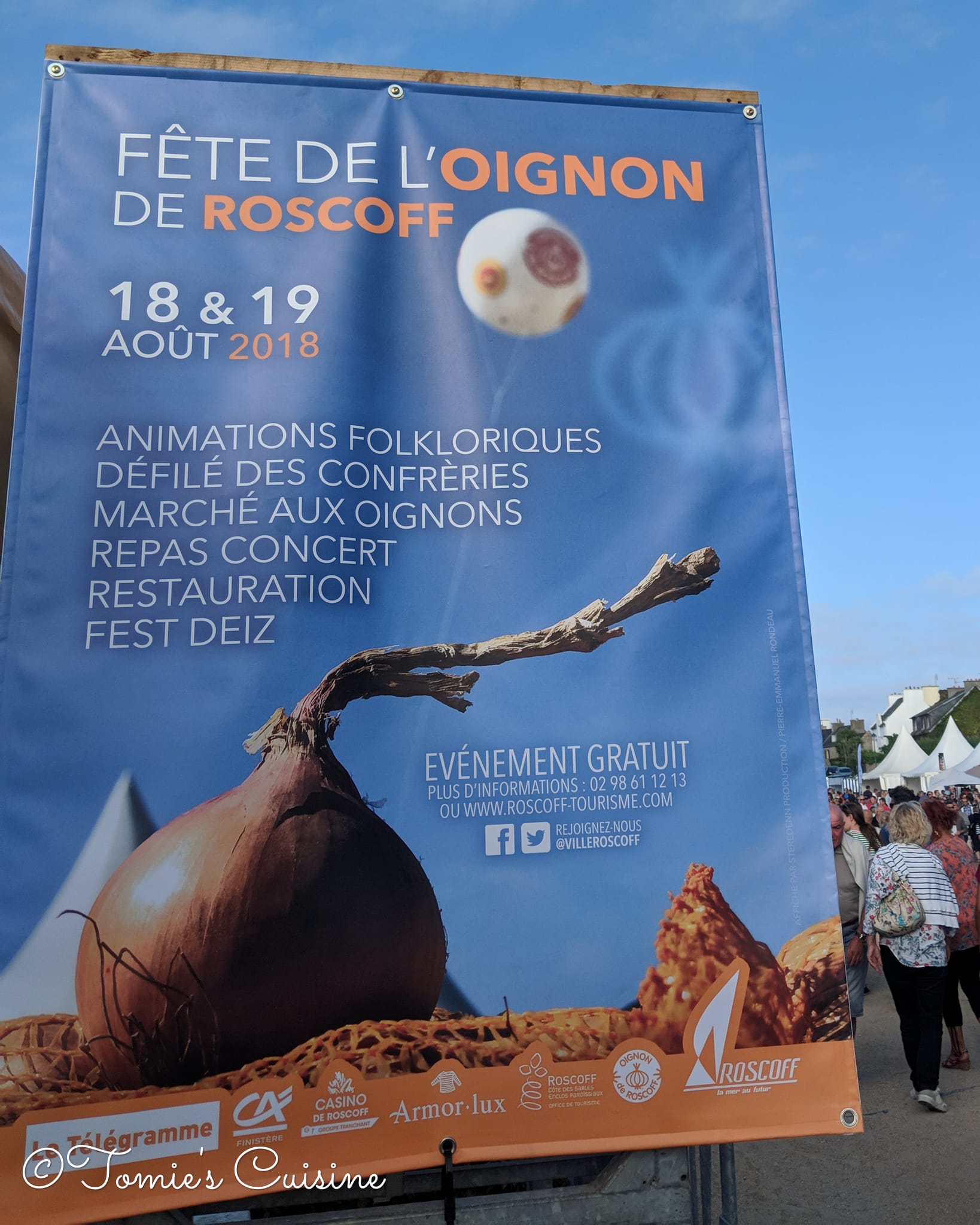
These beautiful pink onions are a speciality from a place called Roscoff. Every summer, they have an onion festival there.
When is the season?
They are harvested between July and September. Luckily, we were there at the end of July and could get this year’s first harvest. It was extremely popular, and the merchants at the Saturday market in Morlaix had already sold them all out by the time we got there. The shop lady from the onion farm in Roscoff told us that they sold 150 bunches before 11 am.
But generally, we can easily find those pink onions year-round in supermarkets around Roscoff.
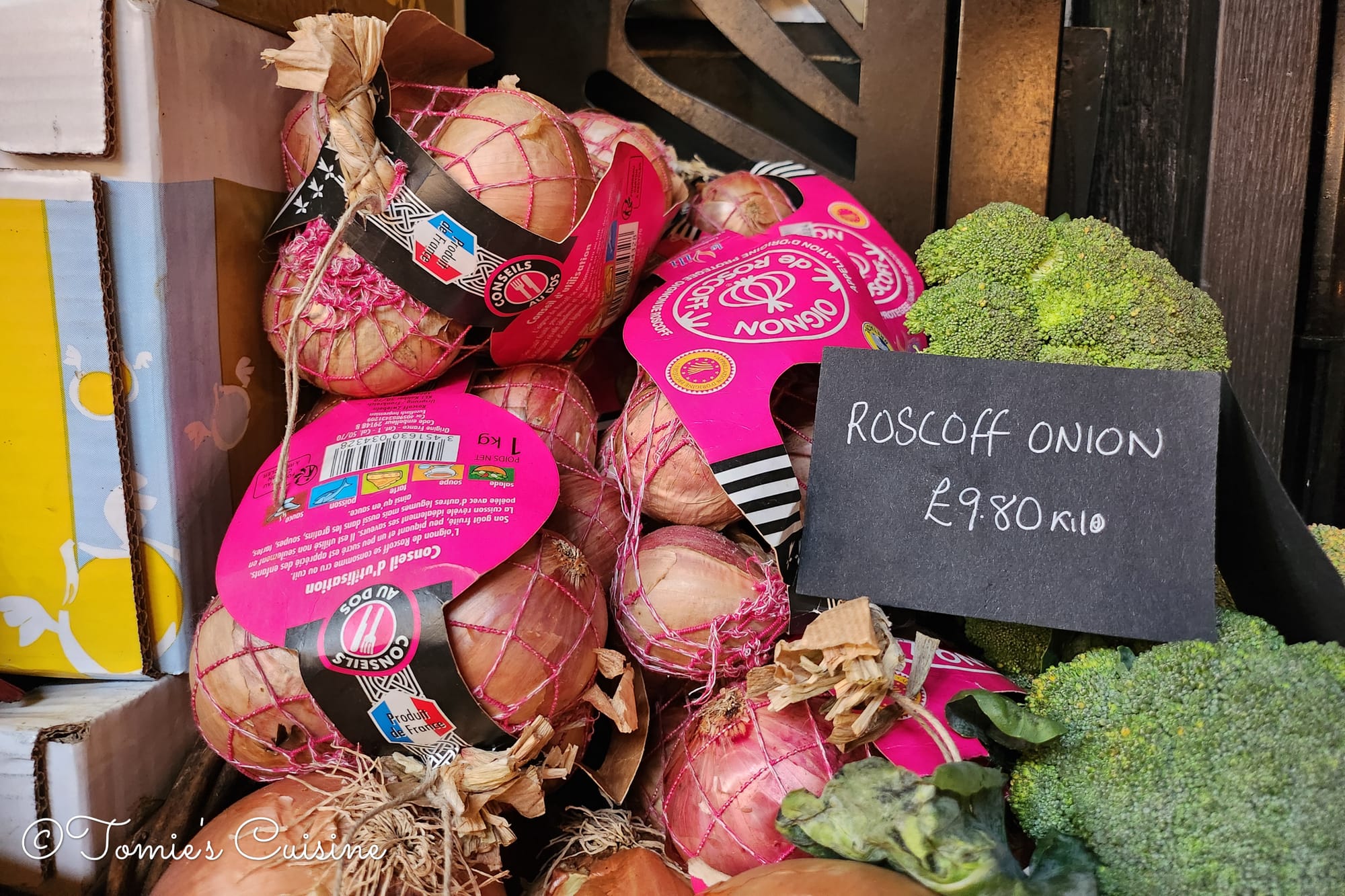
It isn’t easy to find in the UK (we saw them in the Borough Market in London) or they are more expensive.
What does the Roscoff pink onion taste like?
The onions make my eyes waterier, but they taste sweeter, and the texture is soft when cooked.
How do you use it?
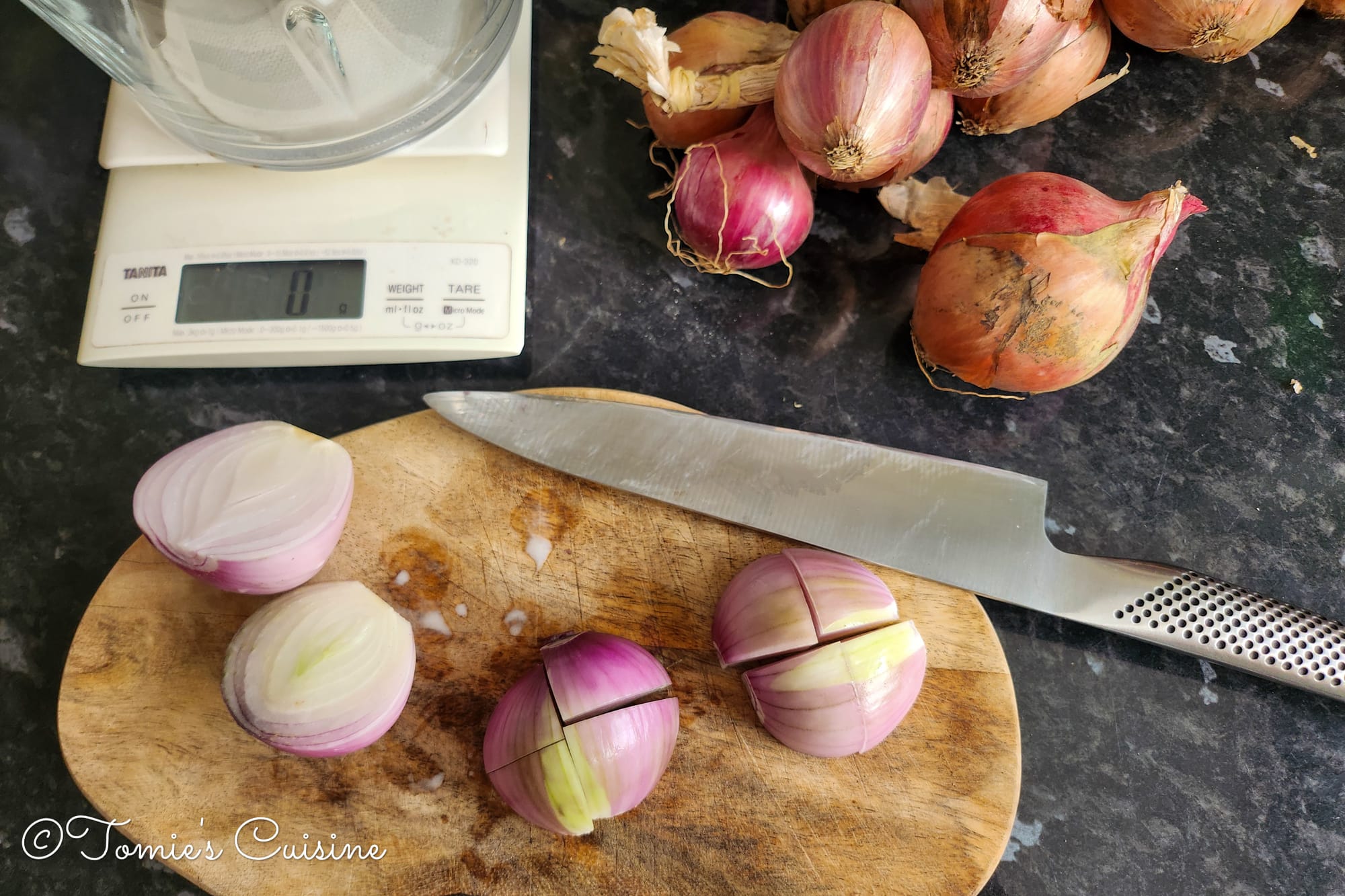
I usually make some onion koji with it to enjoy it longer. The onion gets fermented with the rice koji, and salt brings umami and sweetness.
Of course, the onion is excellent in general cooking recipes like soup, salad, savoury tart, stew, chutney or jam, and it makes the taste better!
Salted Butter / Unsalted Butter
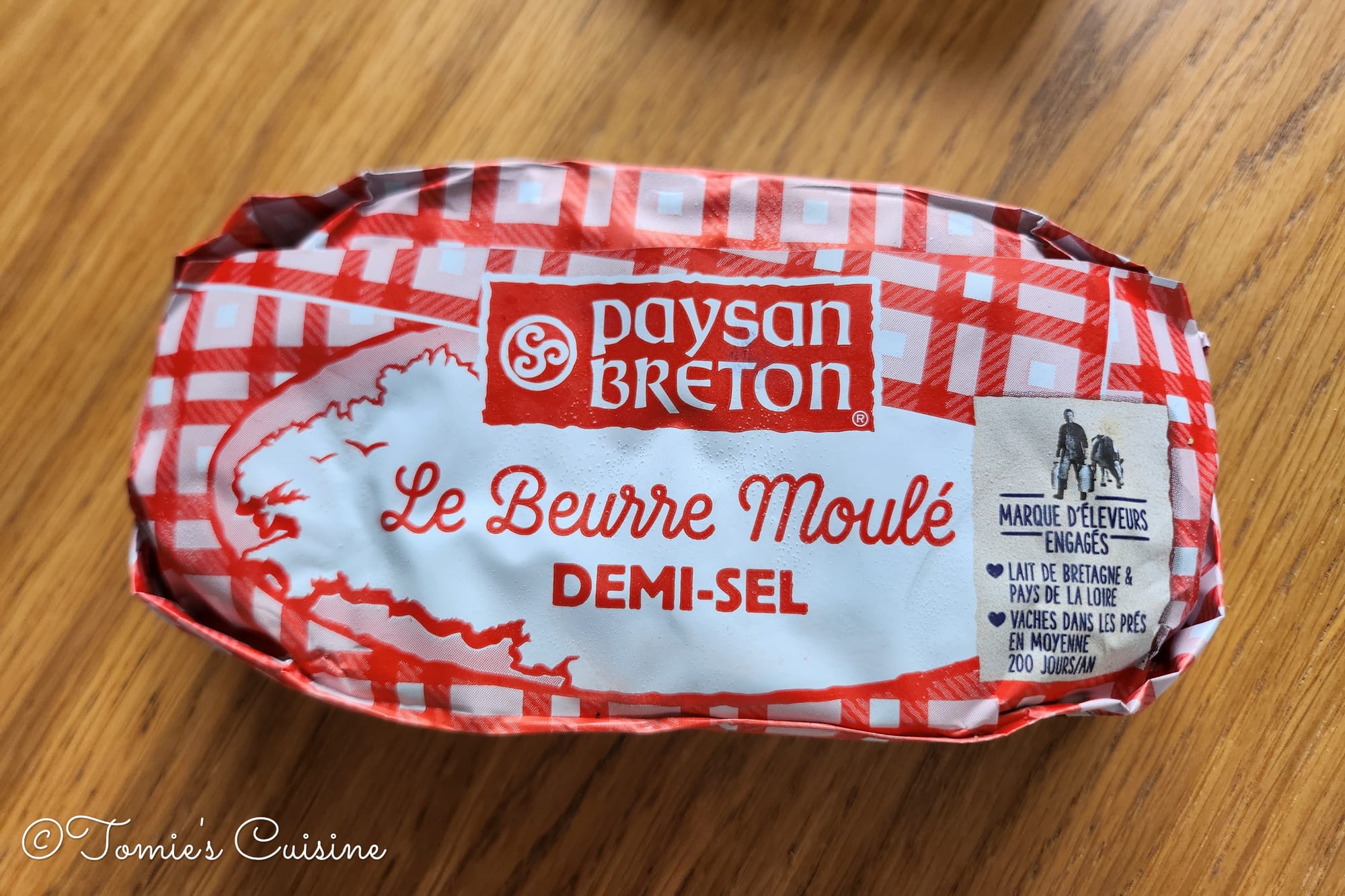
Butter is one of the things we buy the most from Brittany!
Brittany is famous for its dairy products and cakes, which contain a high butter content. If you are a foodie or a massive fan of butter, Beurre Bordier from La Maison du Beurre is one of the most famous butters from Brittany. When we have time to visit St.Malo, we pop into the shop and buy a few different items before leaving. Otherwise, we buy the "Paysan Breton" with the red gingham pattern wrapper from any local supermarket.
What makes this butter so unique?
Since the 1960s, Brittany shifted heavily into more intensive agriculture and animal husbandry. And in 2023, 23% of the milk production came from Brittany. Of these, 21% are used for butter.
Interestingly, Brittany's cooking favours heavily (salted) butter. So you will find butter in many dishes from there that use it one way or another. A few of these are: crêpes, galettes, kouign amann (butter cake), far breton, Vitréais, kig-ha-farz, farz buan, kouigns, quatre-quarts, palet, or galette-saucisse.
Plus, Brittany has the famous Guérande salt, so many butters use this salt, so you may see it featured prominently on the packages. Speaking of Guérande.
Guérande salt (Sel de Guérande)
We always buy three different types of Guérande salt. The salt is unrefined and high in minerals.
Gros sel (coarse salt)
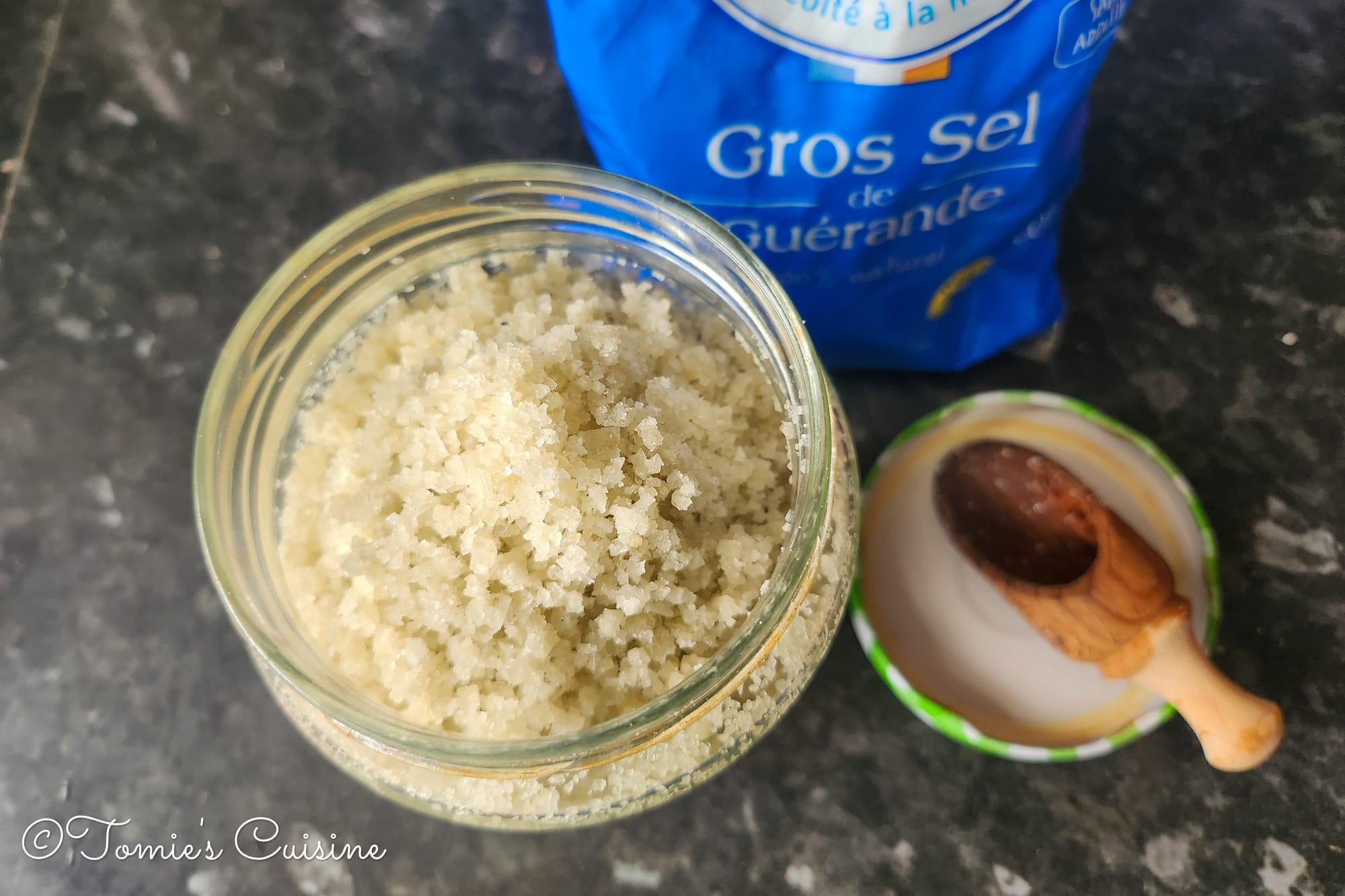
This one is available in many sizes, so we usually grab the biggest one at the local supermarket and top up the salt jar at home.
You can use this coarse salt to cure fish or meat, boil pasta or vegetables, and make rice koji condiments such as:
- Shio (salt) Koji
- Onion Koji
- Shoyu (soy sauce) Koji
Why does the salt have a grey colour?
The grey colour of the coarse salt comes from the traditional harvesting method. The salt comes in contact with the bottom of the pan before being raked. It generally also contains residual moisture, so don't be surprised when you pick the bag.
Fleur de sel (hand-harvested salt)
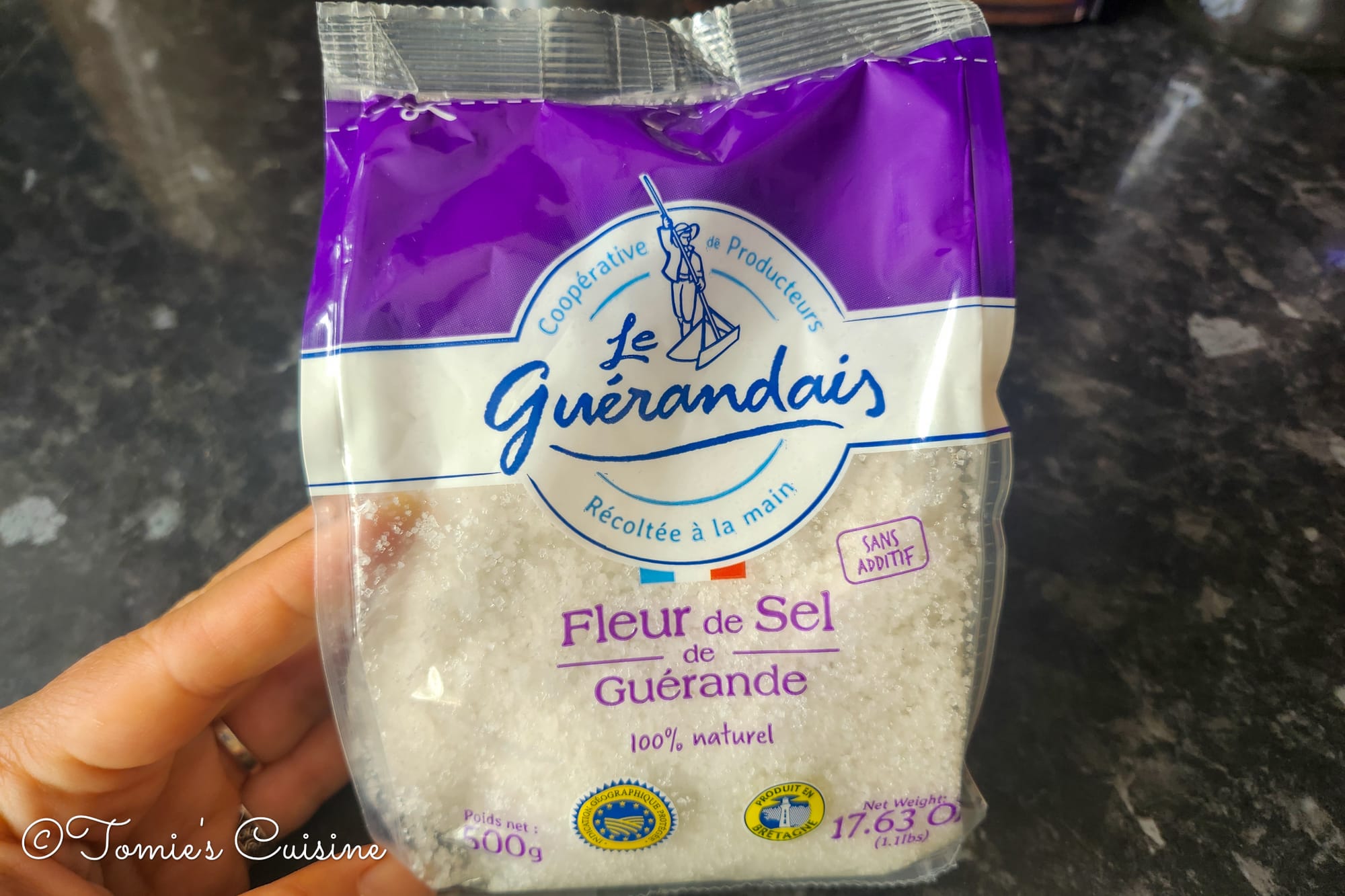
Fleur de sel is the salt harvested very carefully by skilled hand from the surface of the crystallisation ponds. The salt is naturally white and often sprinkled on the dish before serving or enjoyed as a condiment, like dipping fresh radish. I like having boiled eggs with a sprinkle of salt.
Grounded fine salt (Sel moulu)
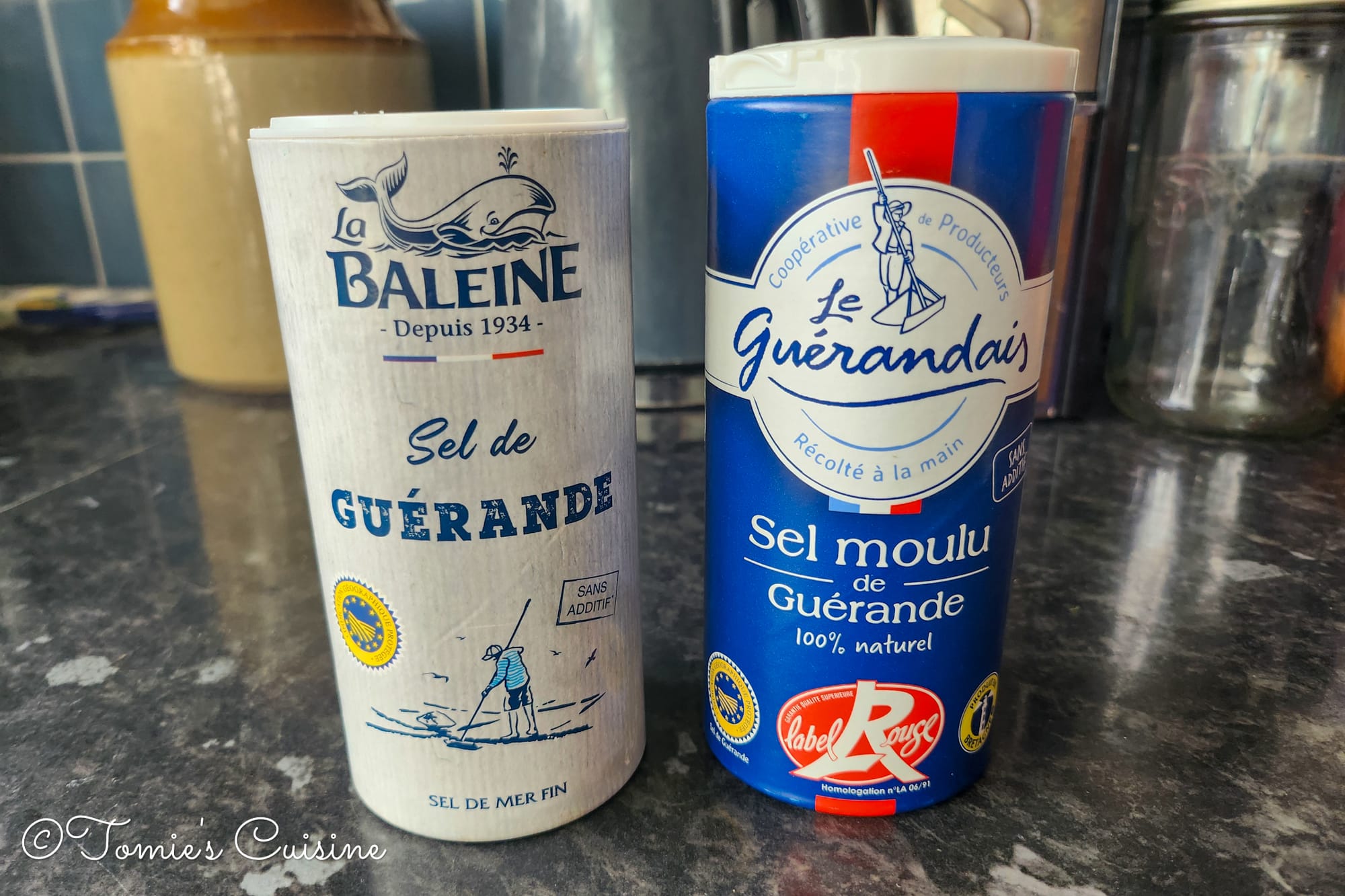
This fine salt is dried and ground the coarse salt. I use it the same way as the fleur de sel but using more casually to season foods.
Saucissons
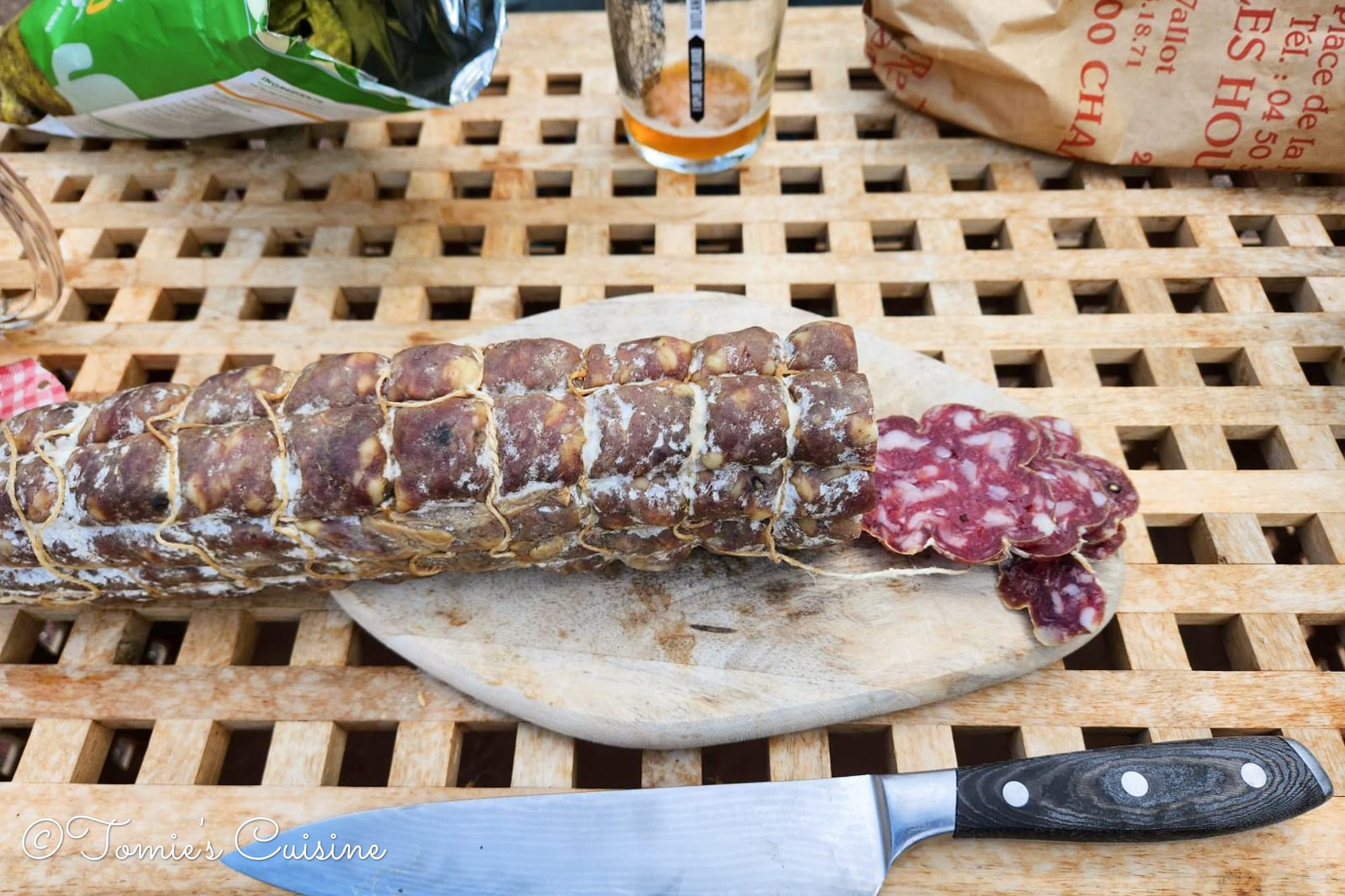
You can get delicious saucisson from pretty much anywhere in France. But I recommend having pork saucisson with a cidre from Brittany. Don’t forget a jar of cornichon and some walnut halves. I love the combination so much.
What kind of flavours are there?
You can find some locally produced saucissons with different ingredients and flavours from almost any local market, such as wild boar (sanglier), walnut (noix), peppercorn (poivre), herbs, piment D’Espelette, mushroom (champignon) and more!
Pork pâté (Pâté de porc)
There are many different kinds of pork pâté in Brittany, but this one is very famous and is sold in many countries. It’s called “Pâté Hénaff” from the eponymous company Hénaff. Their original pork pâté is in blue and yellow tinned packaging. This pâté is made from 100% pork from Brittany, where the company is based, and the rest of the ingredients are strong pork stock, pork liver, Guérande salt and spices.
How shall I eat the pâté?
Pork pâté goes well with cornichon to cut the fattiness, and don’t forget a bottle of chilled cidre and a lovely fresh baguette—canapé style or sandwich, whichever you prefer.
A big jar of cornichon
The bigger jar is always better. As I mentioned in the saucisson and the pork pâté part, we can enjoy the cornichon to add crunchiness and sourness to the mild and fatty meat products.
Can I make something else with cornichon?
Cornichon is a great ingredient to make:
- Homemade tartare sauce
- Beef, salmon or tuna tartare
- Sandwich
Cider (Cidre)
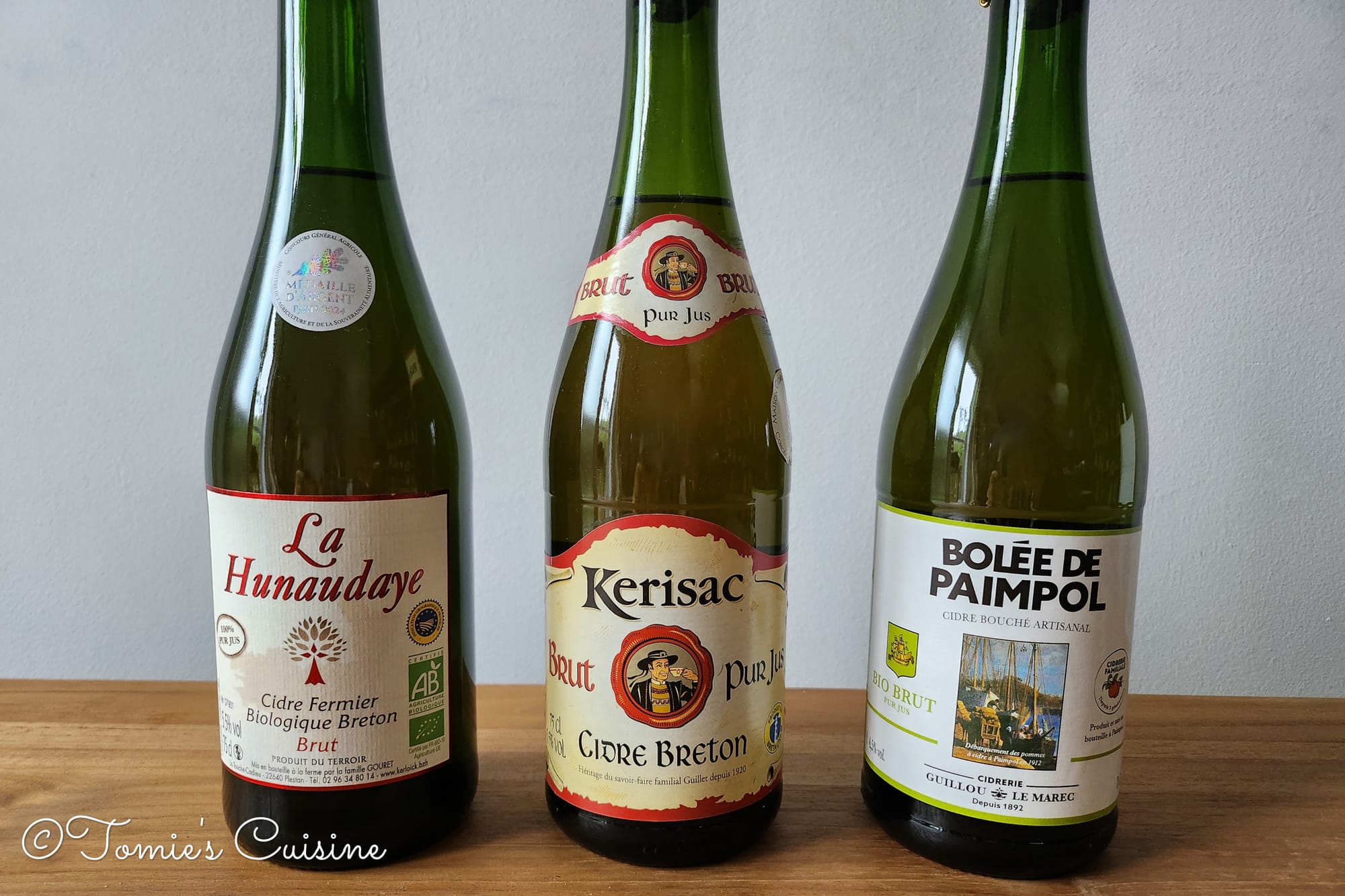
Have you ever tried French cider? We found the taste quite different from the one in the UK, so we prefer the one from Brittany. That said, I prefer drinking beer in England. ☺️
There are many different breweries in Brittany. So let us introduce our favourite ones, which you can easily find.
- Kérisac
- Bolée de Paimpol
- La Hunaudaye
What kind of Brittany cidre we can get?
Let’s break these terms down, starting with the less sweet kind.
Extra Brut (extra dry): This one is somewhat rare, and you will find it in speciality shops. It’s also higher in alcohol (6-10%) since the fermentation ate all the sweetness from the apples, which is why they’ll generally have less than 15g of sugar per litre.
Brut (dry): This kind is our favourite and the most popular. However, be aware that the sugar levels can vary significantly by brand. It can go from 0 to 28g of sugar per litre!
Demi-sec: With a shorter fermentation time, these ciders will be slightly sweeter than the “Brut” ones. The sugar levels will always be over 28g but under 42g, for around 4% alcohol.
Doux (sweet): The sweetest of them all, with over 42g of sugar per litre. The alcohol levels will vary between 1.2% to 4%. Selecting apples of the sweeter variety and the shorter and partial fermentation is essential to make this cider sweeter.
Generally, we buy the “Brut” variety, which is sweet enough, whereas “Doux” is too sweet to enjoy during our meal.
You can also find other terms on the bottles like “bio”, which means “organic”, or even, depending on the season, “premier cru”, like on the Aspall bottles.
Can we get any decent Brittany cider in the UK?
I have tried one called “Cidre Breton Brut Traditionnel”, which we can buy from a wine shop in London, and it was good. When researching this cidre for this article, I discovered that the cidre is actually Kerisac cidre. What a coincidence!
What dish goes well with cidre?
We open a bottle when we eat a pork dish, galette, crêpe or when the weather is nice as an aperitif.
Cakes and biscuits (Gâteaux et biscuits)
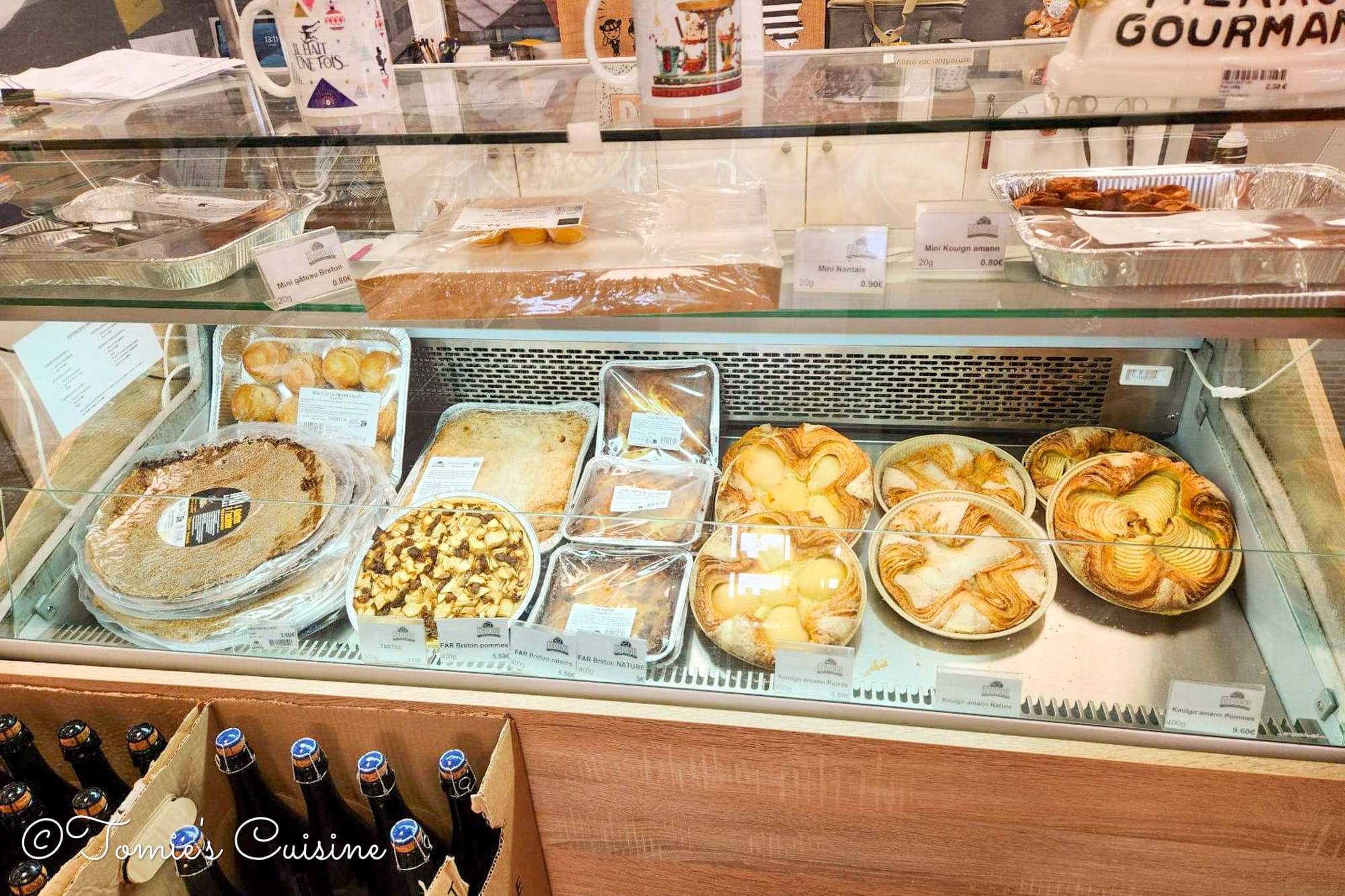
If you like your afternoon tea, don’t forget to bring back some baked cakes with high butter content!
- Breton Quatre quarts (pound cake)
- Palets Breton or Traou-Mad, which means “good things” in Breton (thick butter biscuit)
- Galettes Bretonnes or “sablé Breton (butter biscuit similar to shortbread)
- Crêpes
- Kouign-Amann (literally “bread” and “butter” in Breton)
- Gateau Breton (with various fillings ranging from raspberry to plums)
- Madeleine (small sponge cake) (they’re not from Britanny, but still pair well with coffee or tea)
- and more!
We just need to be careful not to eat too much at once because it’s delicious and high in calories! A good idea is to walk the dog after your afternoon tea.
Preserved seafood from Paimpol
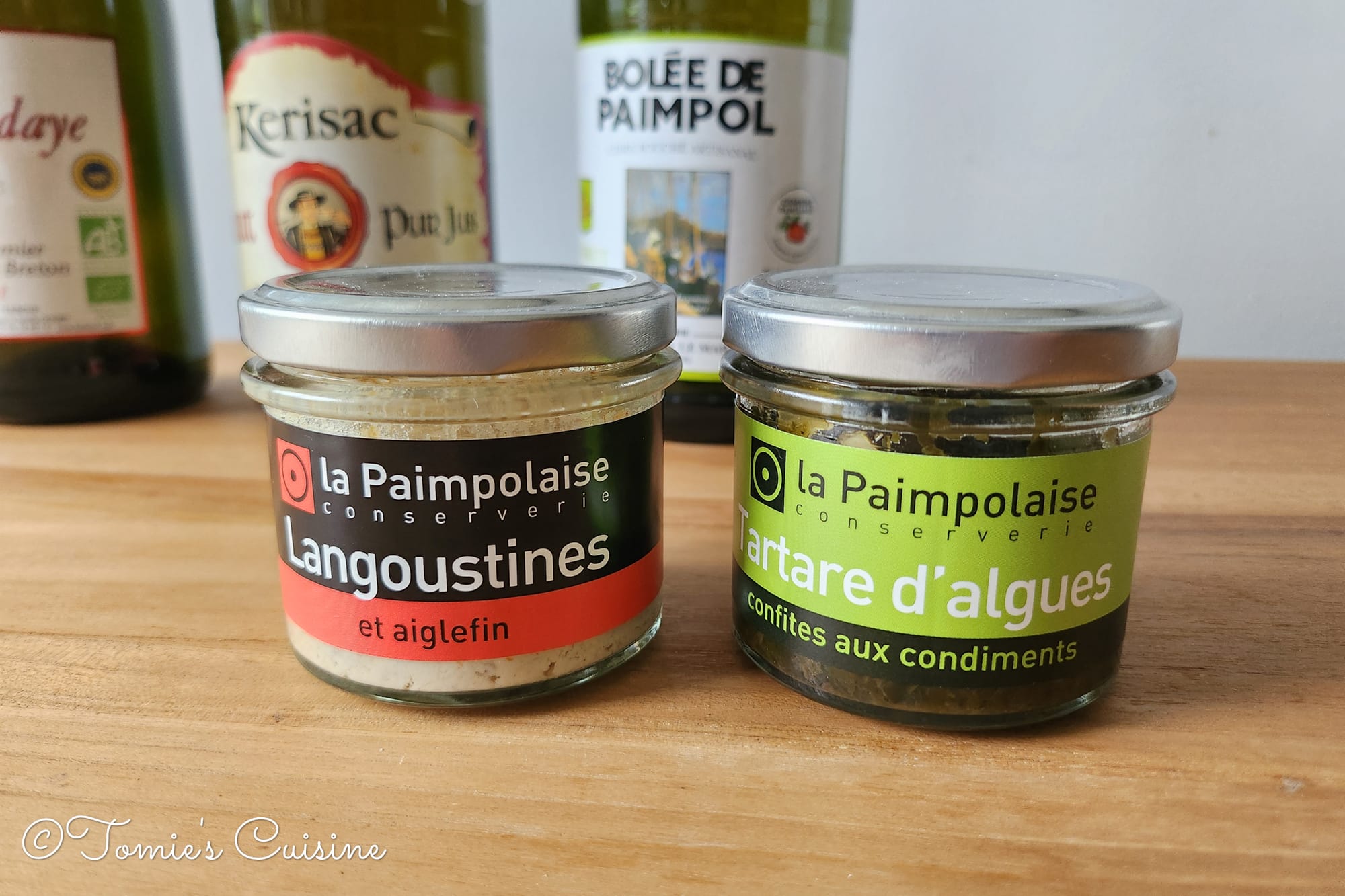
Since the region is located along the English Channel, Brittany is famous for its fresh seafood. This time, we went to a place called Paimpol. This place is famous for its seaside harbour, cidre and preserved seafood.
We bought some preserved seafood called “Tartinables” from La Paimpolaise Conserverie.
“Tartinables” means “spreadable”, and they sell the small crusty toast to go with it.
Their range was so broad that it was difficult to choose! They also have an online shop that ships to the UK if you want to try some!
What we bought from La Paimpolaise Conserverie
- Noix de St-Jacque aux brisures de truffes 1% (Scallop with chopped truffles)
- Langoustines
- Foie de Lotte au lard fume (Monk fish liver with smoked bacon)
- Tartare d'algues confites aux condiments (Seaweed tartare)
- And a bag of the toast aperitifs
Chocolate from Grain de Sail
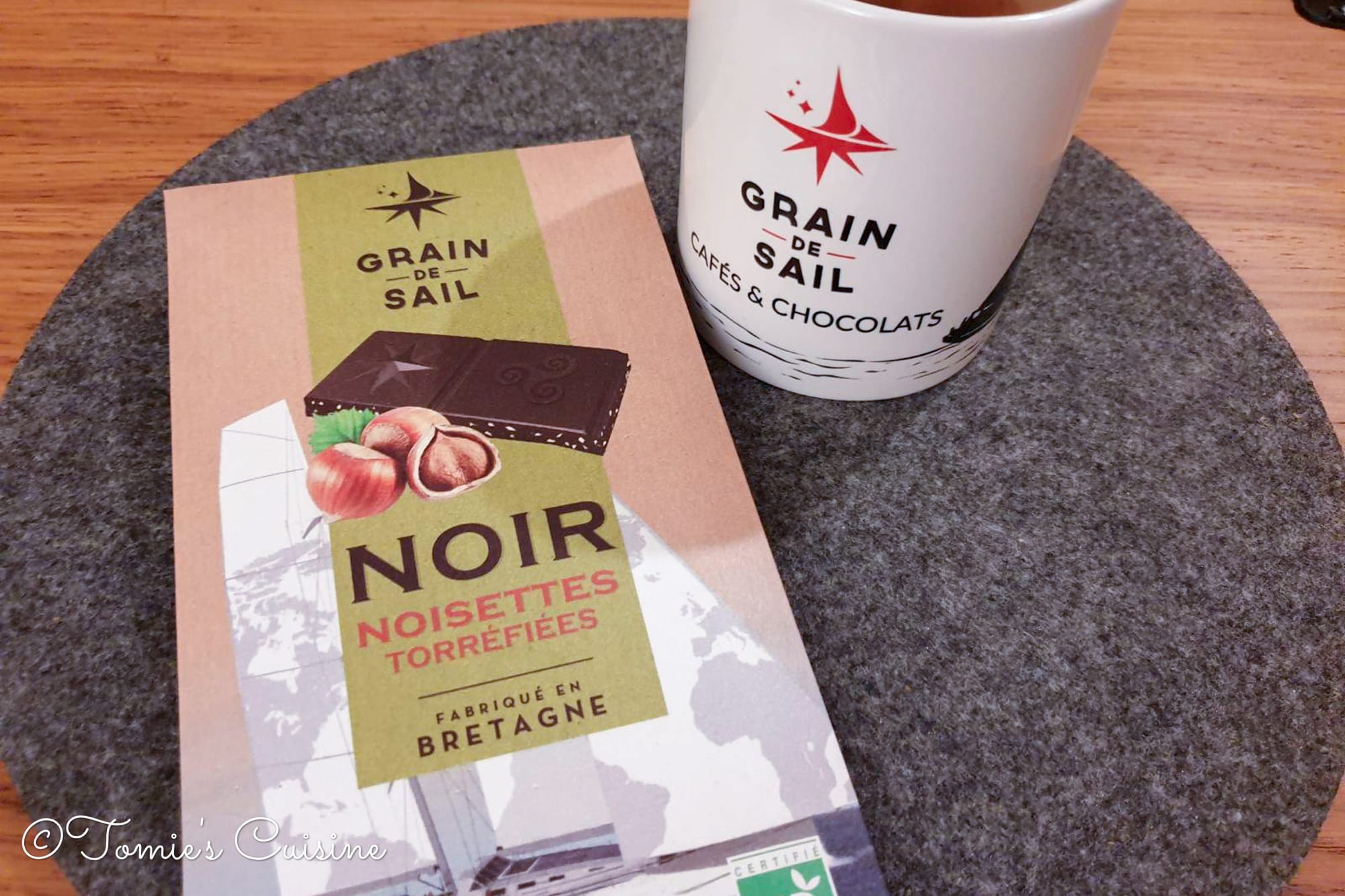
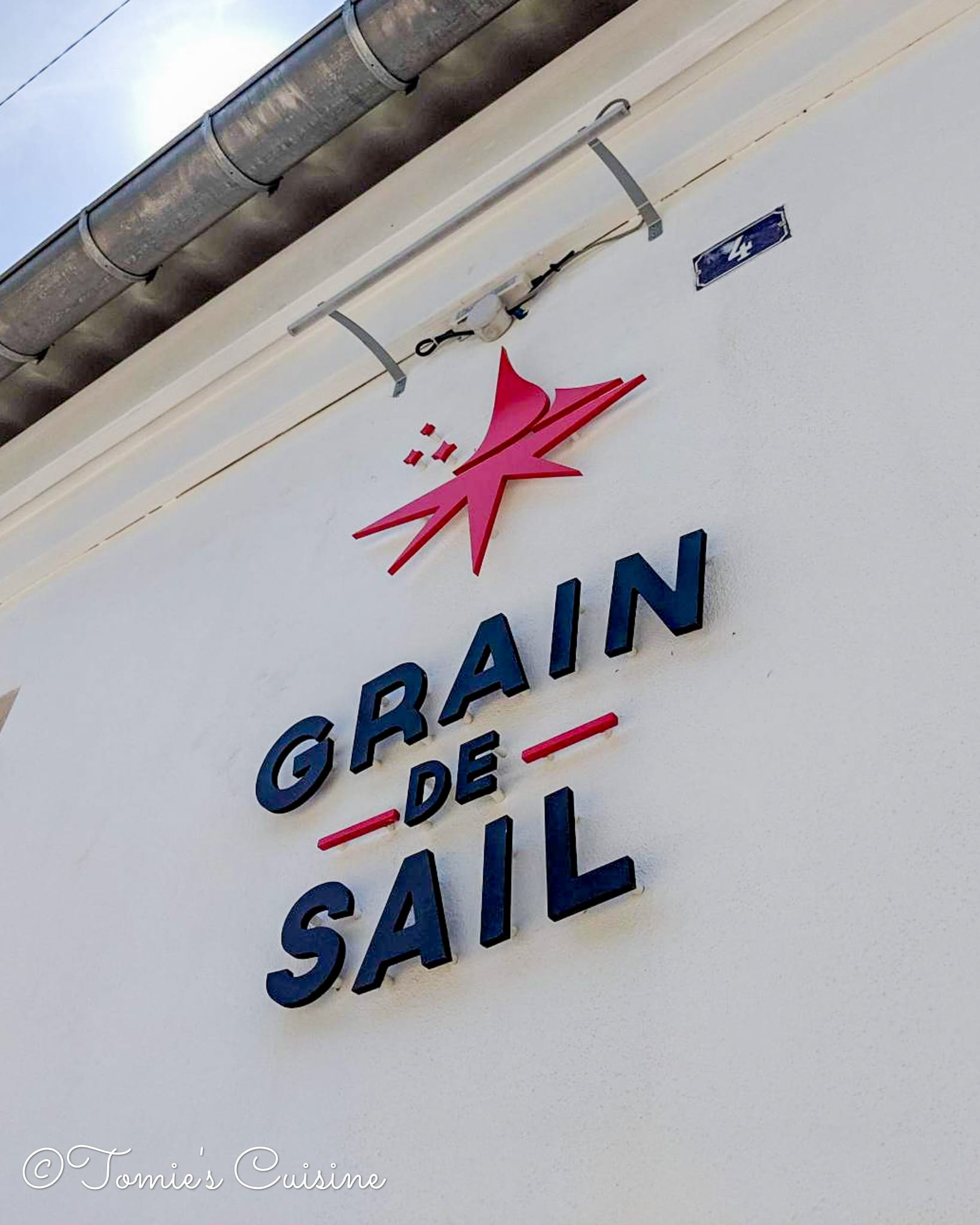
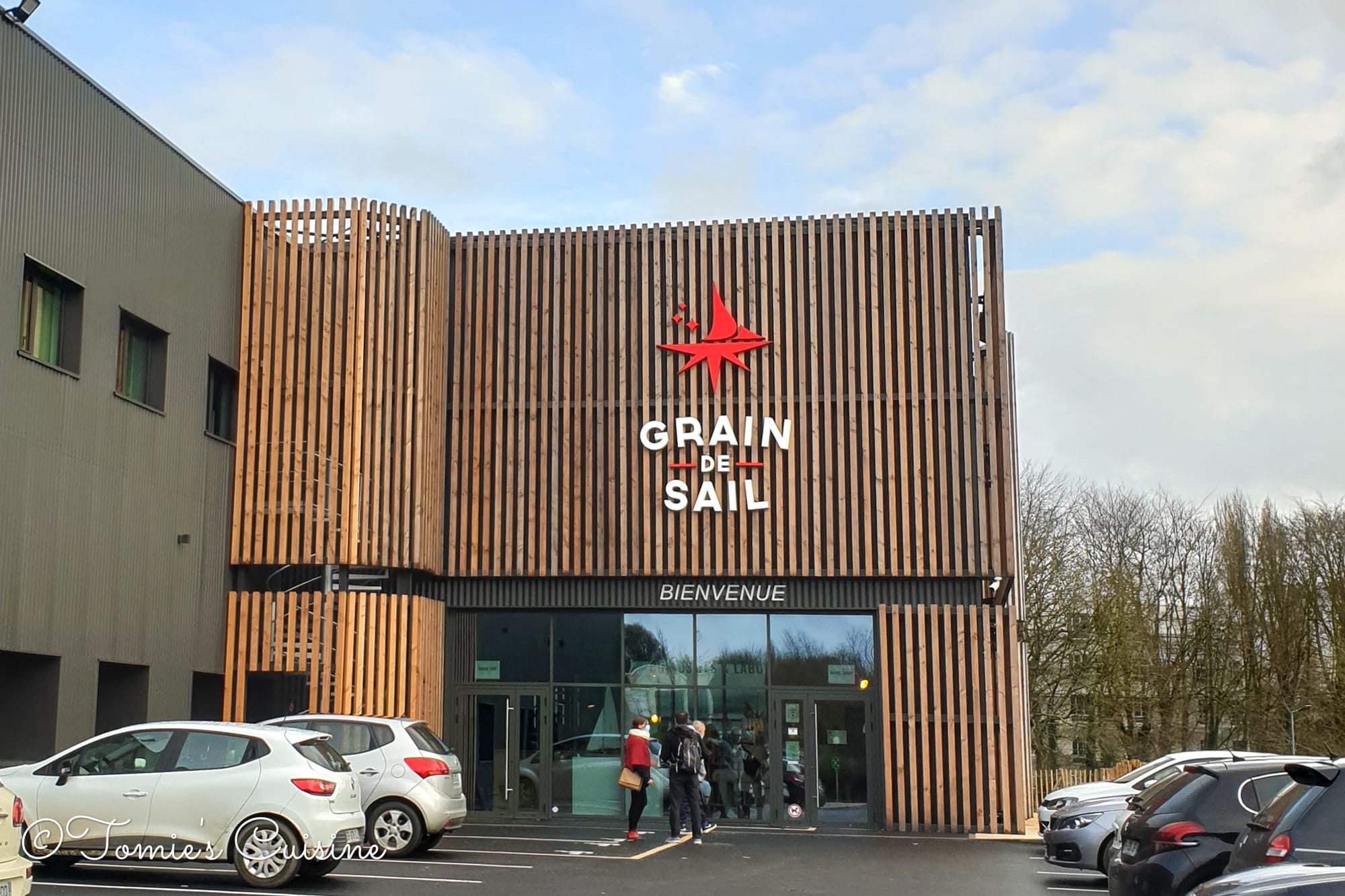
Grain de Sail chocolatier is based in Morlaix and imports its chocolate, coffee, and other goods via its two sailboats to minimise its carbon footprint (you can read more about it here). Since finishing their second sailboat, they have permitted other companies to ship their cargo.
We can buy their products from supermarkets, but they also have two stores in Morlaix and an online shop (it ships only to France, though). They also sell merchandise, coffee and tea-related products in their shops.
Some of our favourite chocolates to munch on
- Buckwheat and raisin (62% cocoa: Dark)
- Sesame (62% cocoa: Dark)
- Raspberry and Praline (62% cocoa: Dark)
- Roasted Hazelnuts and Sea salt (45% cocoa: Milk)
I have just noticed that all these chocolates have crunchy textures! If you can buy chocolate from Grain de Sail, don’t forget to try the buckwheat one! The buckwheat's crunchy texture and taste go well with the chocolate and the raisins!
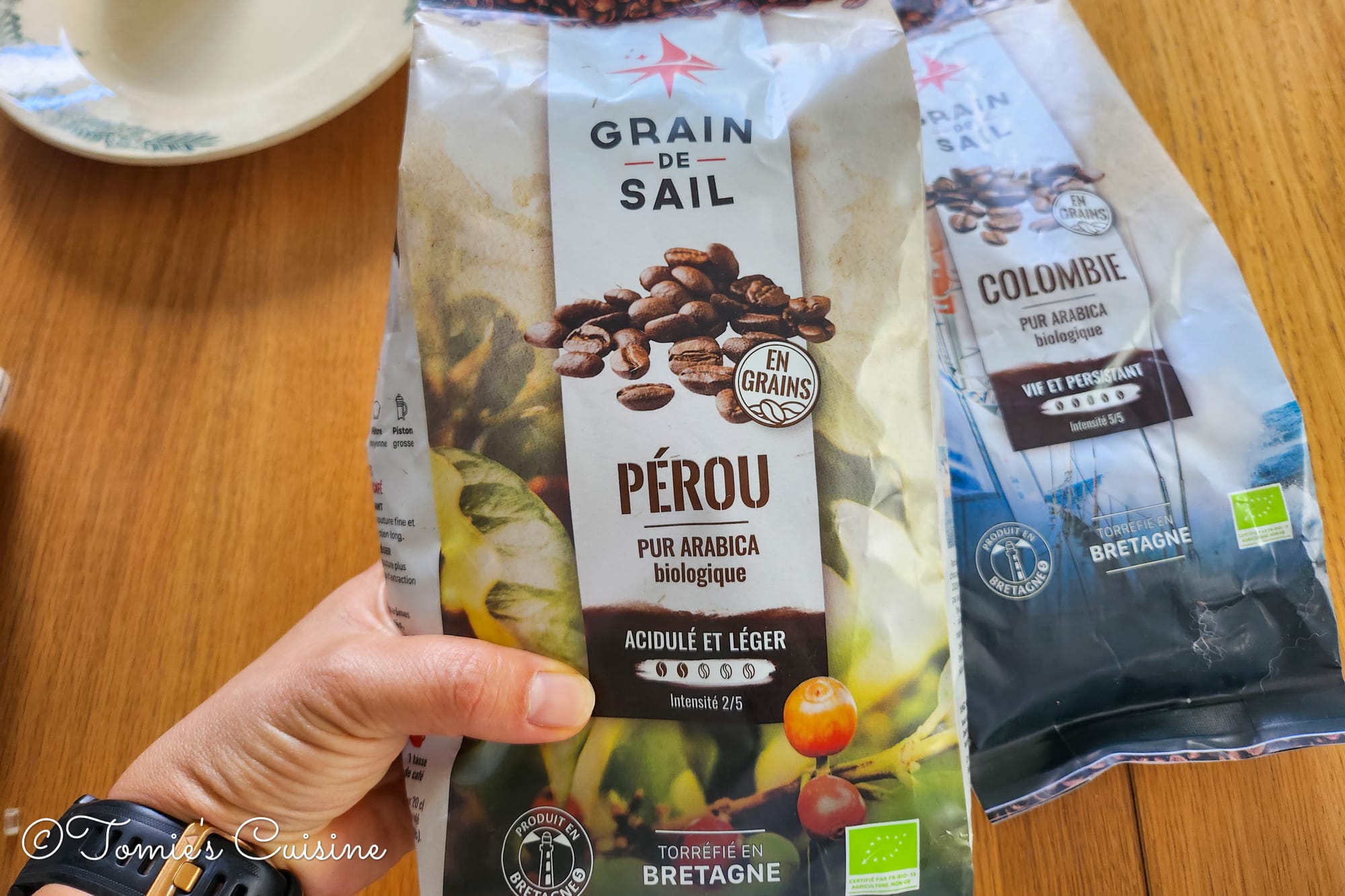
Crisps from Brets
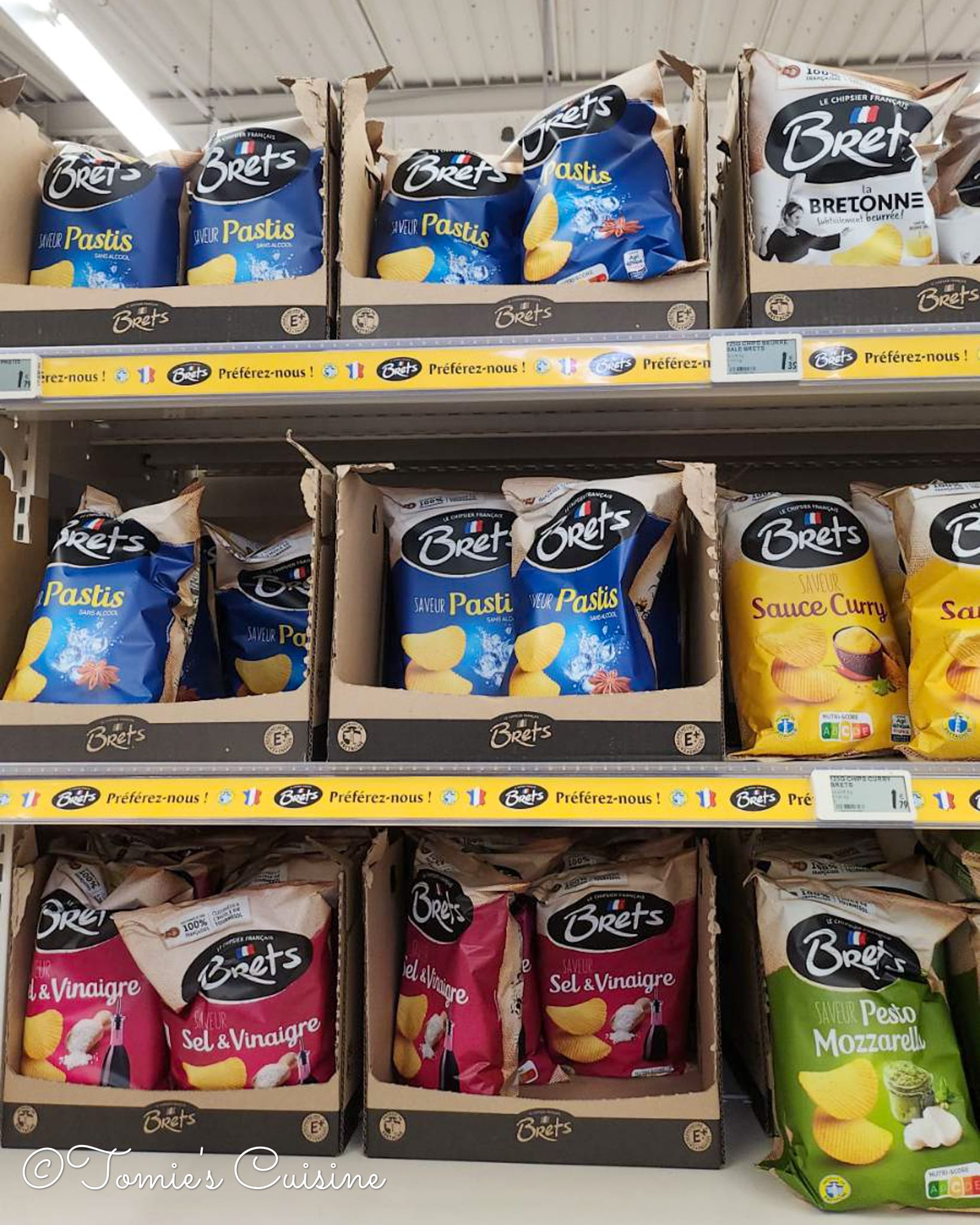
Brets is a Britany-based company that works with around 300 farmers in Brittany; their potatoes are also 100% from France and cooked with sunflower oil. Oh, and they also use Guérande salt!
Brets has many exciting flavours, too! The ones we enjoy are:
- Miel moutarde (honey mustard)
- Fromage du Jura (Jura cheese)
- Chevre piment d’espelette (goat cheese and piment d’espelette chilli)
- Cheddar oignons de Roscoff (Cheddar and Roscoff onions)
- Aioli
- Sel & vinaigre (salt and vinegar)
- Pastis sans alcool (non-alcoholic pastis)
- Fromage frais & fines herbs (creamy soft cheese and herbs)
A lot, isn't it? It's not all the flavours, though! Just look at their online shop so you know what to try next when you’re in France!
Closing words
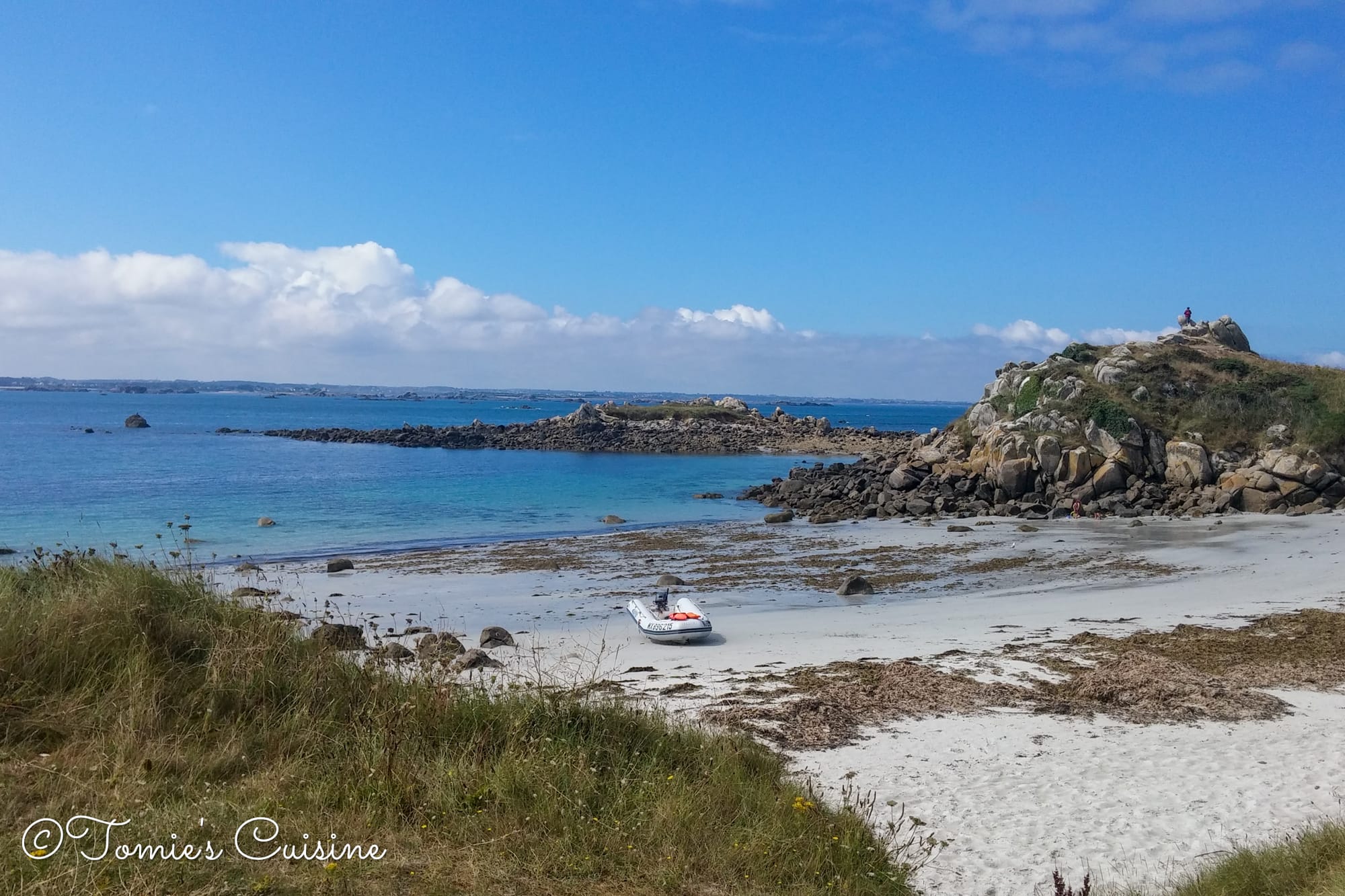
I will show you how much my husband loves the cidre from Brittany.
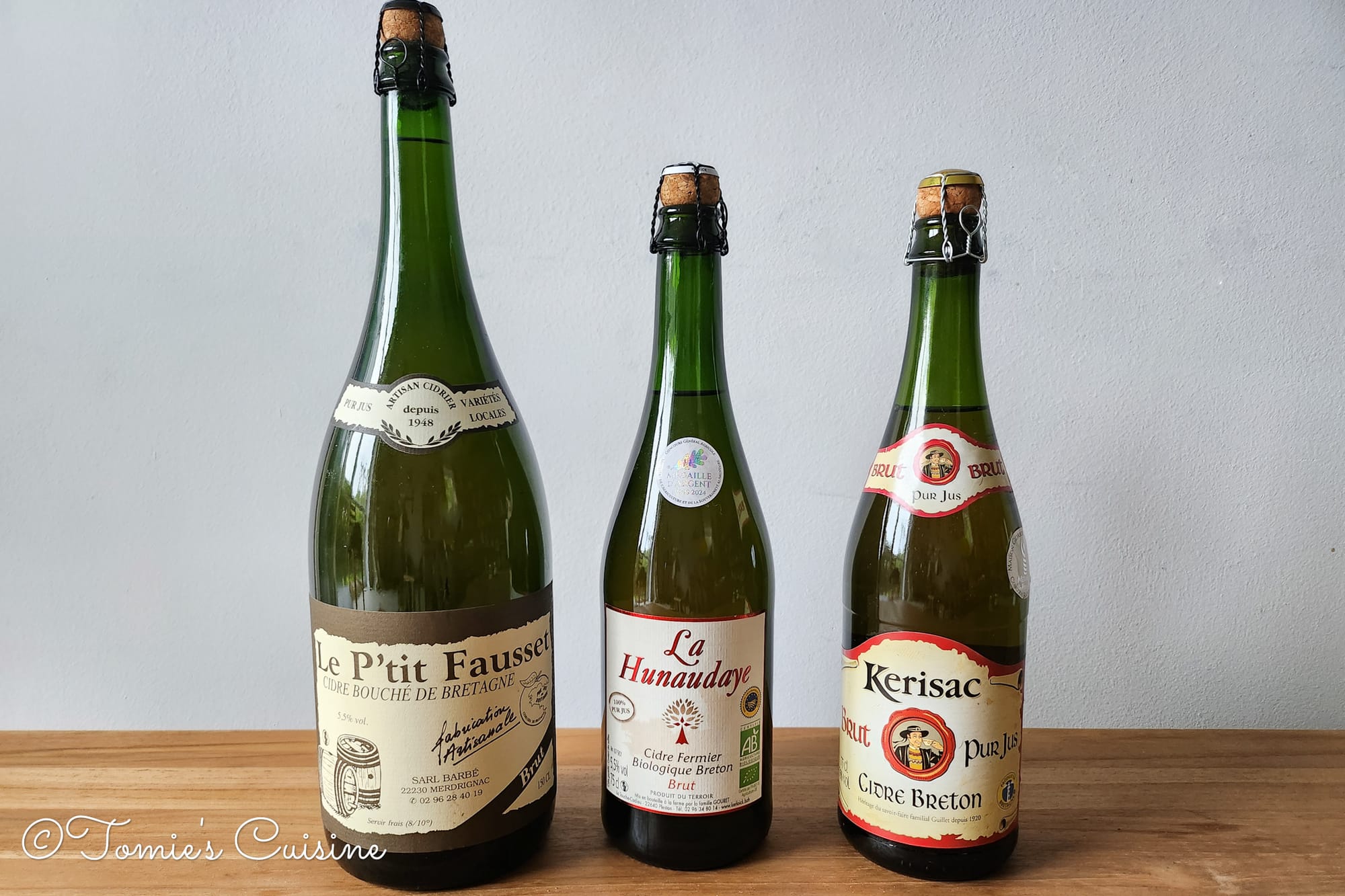
This much.
He found this gigantic bottle at a local Kouign Amann producer called Berrou (by the way, they are delicious, and you can even visit their factory!) in Goulven, near Roscoff, and didn’t hesitate to buy it. We just need to make some space in the fridge to chill it, though.
If you want to know anything else about Brittany or France, please leave a comment on our Instagram, Pinterest, or Facebook pages. We will try our best to answer! Don’t forget to subscribe to our newsletter so you don’t miss our future blog posts about other recipes, eco-friendly tips and travel.
See you in the following article!

